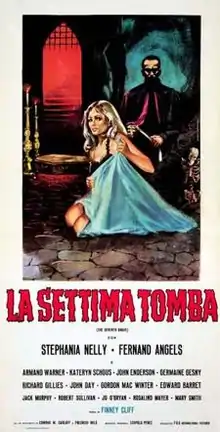The Seventh Grave
The Seventh Grave (Italian: La settima tomba) is a 1965 Italian horror film directed by Garibaldi Serra Caracciolo.
| The Seventh Grave | |
|---|---|
 | |
| Directed by | Garibaldi Serra Caracciolo |
| Produced by |
|
| Screenplay by |
|
| Starring |
|
| Music by | Leopoldo Perez Bonsignore[1] |
| Cinematography | Aldo Greci[1] |
| Edited by | Mariano Arditi[1] |
Release date |
|
Running time | 77 minutes[1] |
| Country | Italy[1] |
| Budget | ₤40 million |
Cast
- Stefania Menchinelli as Katy
- Nando Angelini as Elliot
- Armando Guarnieri as Inspector Martin Wright/Sir Reginald Thorne
- Bruna Baini as Mary Jenkins' lover
- Antonio Casale as Jenkins
- Germana Dominichi as Betty
- Ferruccio Viotti as Pastor Crabbe
- Gianni Dei as Fred, Jenkins' brother
- Calogero Reale as Patrick
Production
The Seventh Grave was produced by F.G.S. International Pictures, a company founded in December 1964 by Felice Falvo, Arturo Giorni and Alessandro Santini.[2]
Santini also wrote the story and screenplay with director Garibaldia Serra Caracciolo and actor Antonio Casale.[2] The film was shot in three and a half weeks at Balsorano castle and Olimpia Studios in Rome from February to March 1965.[3] The films budget was around 40 million Italian lire.[3]
Release
A photonovel of the film was published in issue 52 of the Malìa in May 1965 while the film was released on August 18, 1965.[1] In 1968, Fortuanato Misiano's company Romana Cinematografica bought the rights from the producers and attempted to get the subsidies from 1965's Corona law.[3] The film was rejected by the Ministerial commission who unanimously decided that the "technical eligibility and sufficient artistic, culture and spectacular qualities" that the law demanded were not present.[3]
Reception
Roberto Curti, author of Italian Gothic Horror Films, 1957-1969 noted the films amateur qualities such as breaking the 180 degree rule and lacking continuity between shots and that "lighting was passable at best".[3] The script was described as one that "haphazardly assembles a bunch of Gothic stereotypes" and that the plot, the production clearly saw The Cat and the Canary (1927) "one too many times".[3]
References
Footnotes
- Curti 2015, p. 146.
- Curti 2015, p. 147.
- Curti 2015, p. 148.
Sources
- Curti, Roberto (2015). Italian Gothic Horror Films, 1957-1969. McFarland. ISBN 1476619891.CS1 maint: ref=harv (link)